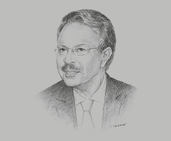Interview : Ahmed Lahlimi Alami
How would you describe the ways in which statistical know-how is transferred in Morocco?
ALAMI: As the national statistics agency, the HCP is the recipient and central source, of micro and macroeconomic information and social data. It is thus the central guarantor and distributor of statistical information standards. The multidimensional poverty map, for example, was developed and published in 2017 from censuses and national surveys on household living standards. It presents the levels of income inequality and access to social services for all basic territorial units and identifies the weight of each of these dimensions in relation to poverty. It also contributes to the delimitation of new frontiers for the National Initiative for Human Development programme. It would be a reference for the implementation of a system identifying those eligible for equitable social protection.
At a time when Morocco is firmly committed to a process of advanced regionalisation, the HCP is also providing regional decision-makers with operational tools for the optimal allocation of resources for their social development programmes. In Morocco, statistics operate according to the IMF’s Special Data Dissemination Standard and UN Statistical Commission guidelines. Recent and ongoing improvements in this area include more systematic coverage of basic territorial units, the diversification of themes and the wider use of new technologies. Morocco must also commit to the use of open data. The challenge of collecting good statistics, however, is costly, and for this reason at the World Congress of Statistics in Marrakech in July 2017 an appeal, supported by the General Assembly, was filed to institute a genuine Marshall Plan of statistics in Africa.
What do you consider to be the main economic benefits of Morocco’s regional reintegration?
ALAMI: Morocco’s relations with Africa and its neighbours in the Economic Community of West African States (ECOWAS) do not date from its reintegration into the African Union, but from shared geography, history, culture and the challenges of the future. On the economic front, trade with ECOWAS increased by an annual average of nearly 9% in six years and gross investment flows by 54%. Moreover, from this accession, Morocco is able to retain its geostrategic position as a central player in the ongoing move towards regional integration. The pooling of the natural, energetic and human potential of all the countries of West Africa is likely to link the Gulf of Guinea to the Mediterranean and the European Union, through a consolidation of development clusters backed by the planned 5000 km Nigeria-Morocco gas pipeline.
How would you describe Morocco’s economic growth prospects for 2018?
ALAMI: In 2018 Morocco is expected to benefit from the successful alignment of growth cycles across the world, meaning levels of external demand should see improvement. Despite the coordinated availability of inputs and good management of their use within the framework of the Green Morocco Plan, the contribution of the agricultural sector to growth will continue to depend on a good rainfall distribution over time and area. Despite a slight increase, non-agricultural activities will still remain, according to our forecasts, far from their average annual growth rate for the 2008-11 period. Overall GDP should increase by around 3% in 2018, instead of 4% in 2017. Thus, the challenge of diversifying the secondary sector is at the heart of the Industrial Acceleration Plan. Rapidly expanding new industries, particularly in the automotive and aeronautics sectors, are now improving the volume of foreign trade, without at this stage improving the structural deficit balances caused by the weight of induced imports. In the food, textile, chemical and para-chemical industries, among others, Morocco boasts a number of historical achievements, the exploitation of which has significant potential to create value added and jobs.

